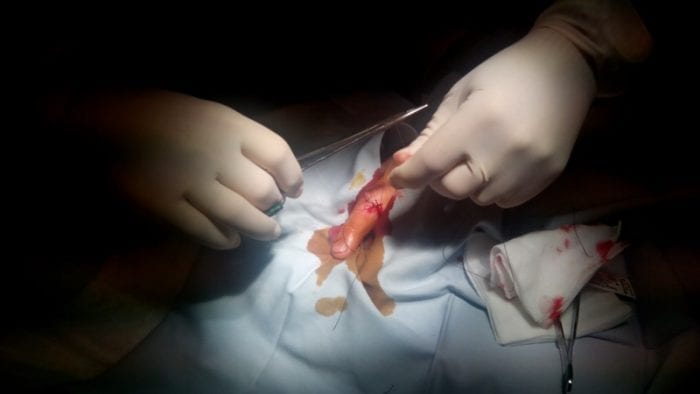When you think of trigger fingers in toddlers, you may imagine a toddler who is a good shot with their toy gun as they play pretend cowboys. However, a trigger finger, also known as a trigger thumb, is quite serious. Its medical name also knows this of stenosing tenosynovitis. Occurring in 3 out of 1,000 children, it’s something that may need treatment.
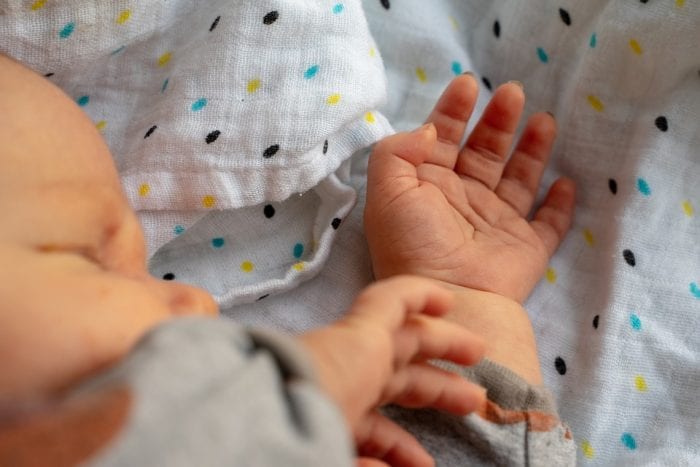
What Is A Trigger Finger?
A trigger finger is when your toddler’s thumb or finger clicks or pops when they straighten it. This is because the tendons of the finger responsible for flexing are too big and can’t slide smoothly.
Why is this a bad thing? While it’s painless on its own, your child may feel pain when they try to straighten their fingers. Then, they may notice their fingers stuck. That’s never good, especially if it’s the thumb. With the thumb being so used, it can be a disaster if your toddler has to use it.
Trigger fingers vary in severity, with some being so severe, your kid cannot straighten their digit at all and need surgery to fix it.
With pediatric trigger thumb, the child’s thumb can’t be moved about, and it might only be fixed with a flexion contracture. Sometimes, when it’s in a straight position it can hurt, or even the child may not be able to move it into a straight position. Pediatric trigger thumb usually has the thumb in a flexed position, with the base of the thumb near the child’s body when it’s in a flexed position.
This can happen in children as young as a year of age, where they’re stuck in a bent position. This flexed position can’t normally be moved easily, so the child’s thumb is permanently stuck in a flexed position.
The signs and symptoms with pediatric trigger thumb usually involve a child being unable to move their finger straight, and it’s permanently stuck in a bent position. The weight thing about this is the base of the thumb is usually normal, so the base of the thumb usually doesn’t have issues, but the upper extremity of the thumb is permanently stuck, so your child may be able to move the base of the thumb, but the upper extremity isn’t really able to be moved.
Sometimes, the child’s thumb may be stuck in a bent position. This is normally not due to injuries, but it can be in some cases if it happens in older children. Pediatric trigger thumb usually occurs in children up to age of 3.

The Cause
You may wonder what the cause(s) of trigger fingers in toddlers are. You may think the child has injured their finger by playing too hard. However, trigger fingers are usually not caused by any injury, but instead, it’s just due to the tendons being too big. It’s something that doesn’t have a direct cause, and during birth, you may not notice it.
It’s associated with toddlers a lot, but you may also notice it in young children as well, which can be a problem as well.
With that said, some things increase the risk of trigger fingers. These include:
Repeated injury to the hand may cause trigger fingers.
Inflammatory disease.
Diabetes.
Kidney disease.
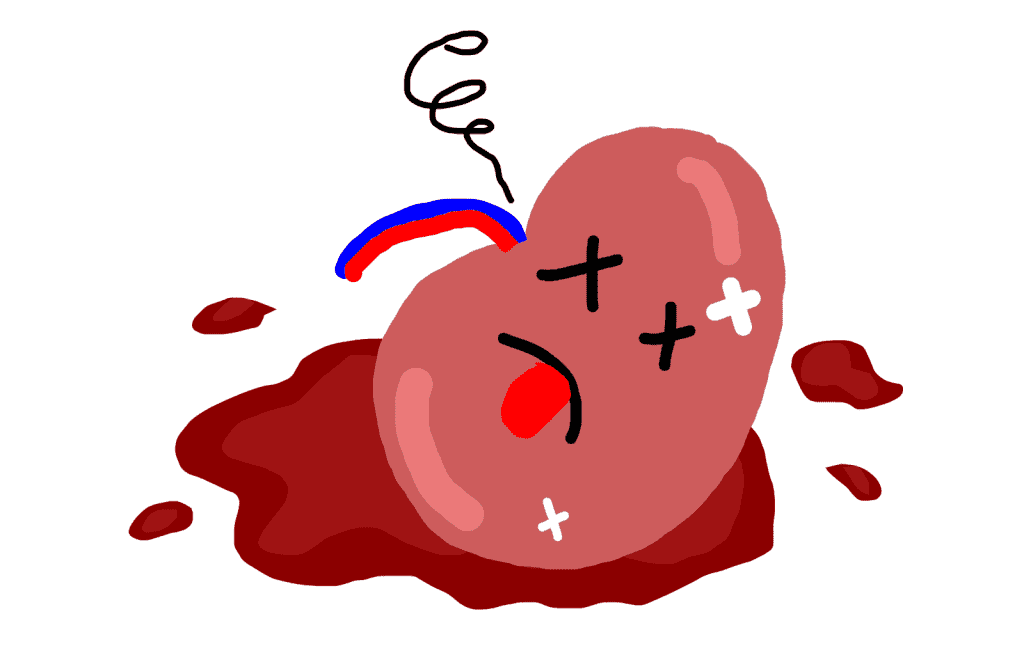
The Signs
If you suspect your child has trigger fingers, here are a few signs to be on the lookout for.
- Their Fingers Are Stiff
If you notice any unusual stiffness, this may be a sign.
- Their Fingers Pop When Straightened
If they bend or straighten their finger or thumb, it could be a sign of a trigger finger. Usually, this accompanied by a painful pop, so beware.
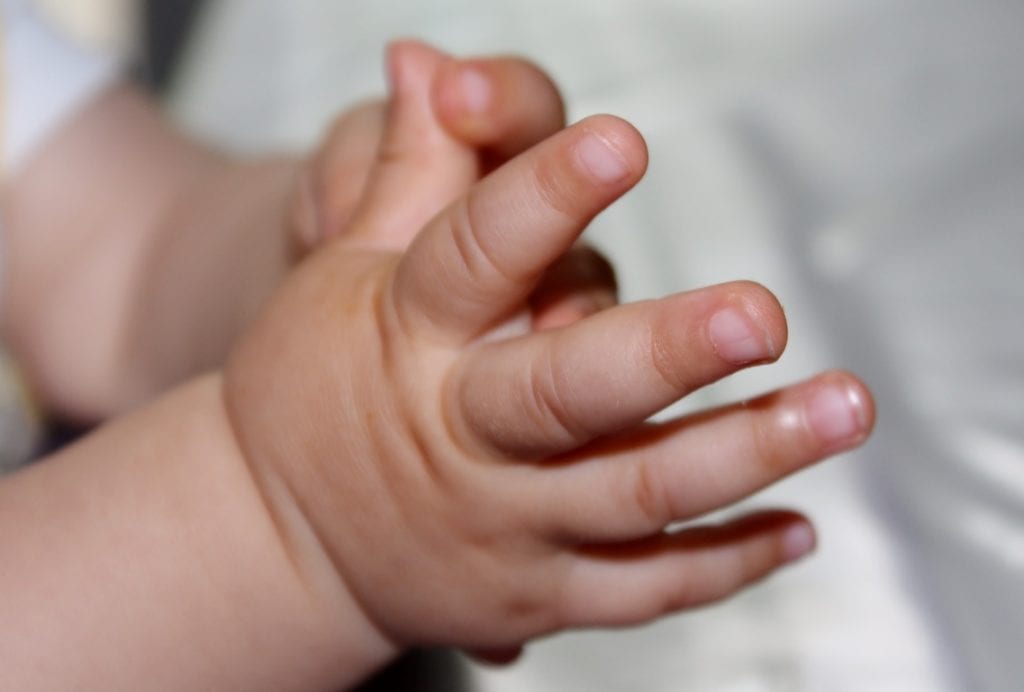
- The Fingers Get Stuck
If the fingers, when straightened or bent, end up getting stuck, this may be a sign of trigger finger.
- The Symptoms Can Be Worse in the Morning
The time of day can affect how the symptoms are. During the morning, there is a chance that the symptoms may be worse, so that’s a sign that it could be trigger finger or thumb at work.
Now, these symptoms aren’t just for trigger fingers, either. They may find something such as juvenile arthritis. If you want to rule it out, your best bet is to go to a doctor.
Testing For Trigger Finger
If you suspect your child has a trigger finger or thumb, you should not hesitate, and you should take them to the doctor and see if they do have it. A doctor will usually figure it out through a physical exam. Sometimes, they may need an X-ray, but those circumstances are quite rare.
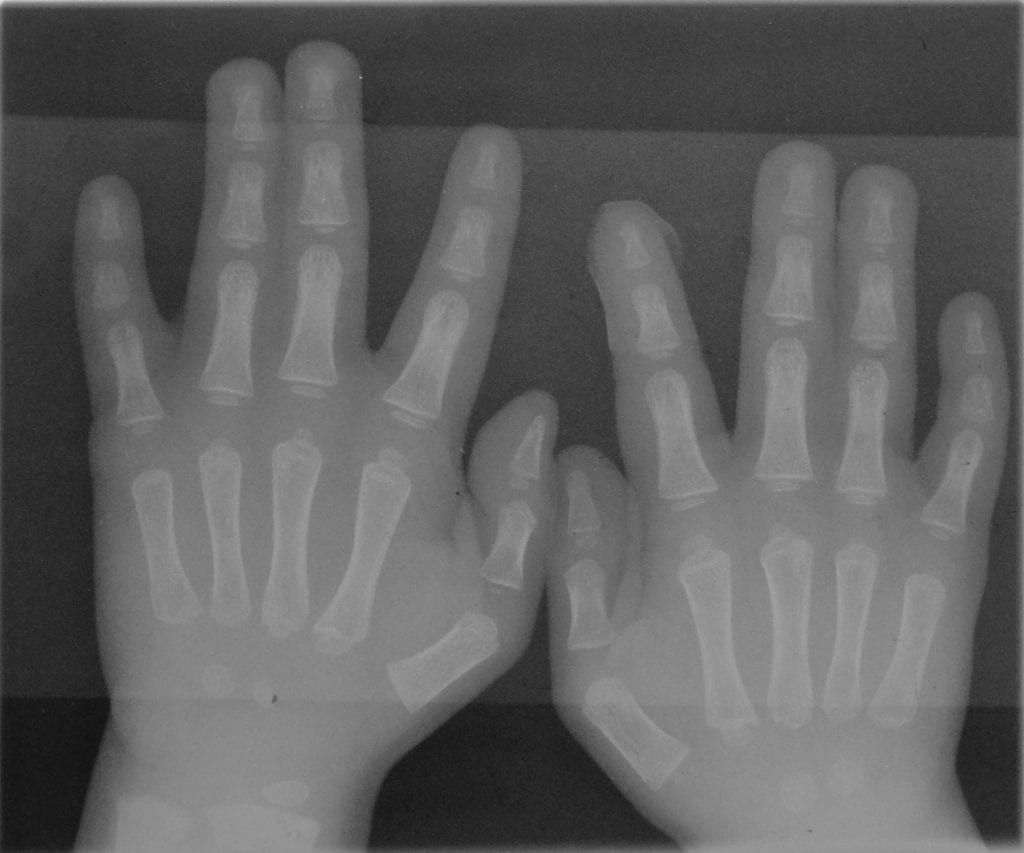
Treating It
If you’re worried about your toddler’s trigger finger, it’s understandable, and you may wonder how it’s treated.
For a third of children who have it, they will outgrow it. If your child outgrows it, this usually happens after their first birthday. If your kid is under one, your doctor may tell you to wait it out, as correcting it when it has a possibility of correcting itself is something to avoid.
However, if it doesn’t go away, you may need surgery.
Upper Extremity Program
Sometimes, after a child’s gone to a children’s hospital, they may end up getting into the upper extremity program. The upper extremity program is a way to help children with a variety of conditions that affect the thumb in children but also the arms as well. This includes pediatric trigger thumb, but it also may be other cases than pediatric trigger thumb. These can help a child with conditions including hand fractures, or arm fractures.
While the upper extremity program at a children’s hospital may look at the thumb in children, the hand and upper extremity program may also diagnose possible conditions a child has, and they’ll treat this directly at the children’s hospital.
If there are issues with the tendon sheath for example, the healthcare professionals may work to connect the tendon sheath again to certain tendons. And of course, if there is trauma to the tendon sheath and other parts of the nerves and tendons, this can be used to treat it.
This does treat pediatric trigger thumb, since they may have to reconnect the trigger sheath. But this goes beyond children trigger thumb, as it can help with other conditions. The healthcare professionals understand that the body is changing, and children trigger thumb is unfortunately common for some children. If other place then a child’s thumb are affected, these health care professionals can help. You can also find a doctor that works with children who suffer from this too.
This program can right fingers in a bent position, and you can also find a doctor who will help with the child getting the help they need to right their thumb.
The upper extremity program is also a form of sports medicine, since you can find a doctor who will help with trigger thumb in children and adults. The healthcare professionals will look at your medical records, and help you get the right assistance you need.
Trigger Finger Surgery
Surgery is always a little bit scary when it’s a little one on the line. Luckily, the surgery is easy and allows your child to live a life without trigger fingers. Between 1-3 years, surgery usually happens. The surgery involves the surgeon helping the tendon glide better. This usually involves removing the tendon’s sheath or removing part of the tendon.
Of course, they will make sure there is no other way to treat it. Is it inflammation? If so, is it treatable? The doctors know that surgery is always a last resort, and by knowing this, they can help make the best determination for surgery.
After surgery, your child will be able to go home almost immediately. There will be a bandage over the incision, and they won’t be able to use their hand. This is needed for healing, so make sure your toddler isn’t messing with it. This can make the problem worse.
After a bit, the doctor will take off the bandaging, and the child can use their hand. There are sutures, and these will fall out without any needed intervention. This usually happens a few weeks after the surgery.
If the pain is unbearable and you haven’t had a chance to find a doctor to help with therapy for this, you may need to go to urgent care. If it suddenly happens without any possible reasoning, you may need to go urgent care too. Usually, you do need to request an appointment for surgery, but if a child’s life is in danger, they will be rushed to urgent care where healthcare professionals will help them get the help they need.
This type of surgery usually occurs at a children’s hospital. Since it usually isn’t a time-sensitive surgery, you can request an appointment to get the surgery at a children’s hospital. When you do request an appointment, understand that going in for surgery at a children’s hospital is kind of the last thing you do. You can request an appointment with a doctor at a children’s hospital., and if your doctor has exhausted all options, then surgery at a children’s hospital. needs to be done.
If your child has gotten some physical therapy for flexion contracture in their thumb, and the flexion contracture is still there, you can then schedule an appointment for surgery at the children’s hospital.
After you schedule and appointment, you can of course bring your child into the children’s hospital. They will get prepared for surgery, and it will happen.
Usually, after surgery they will need some time to recover, but usually they’ll be fine after. You may need to find a doctor find a physical therapist, or other type of person for the child too. The reason why you may need to find a doctor find a physical therapist for them is because they may struggle with limited range, and you can of course help them get their ability to move their joints again.
After the surgery heals, you may need a follow-up to make sure everything else is going well. Once that happens, and the doctor sees that everything is going well, you probably won’t need to deal with the problem ever again.
Can The Baby Get It Again?
You may wonder if reoccurring trigger fingers in toddlers are possible. Once it’s fixed, can it happen again? If so, will you need another surgery?
Luckily, the trigger finger rarely happens again. In almost all cases, it’s gone for good, and you won’t have to worry about it. Your toddler can rest easy, knowing they can use their fingers quite well.
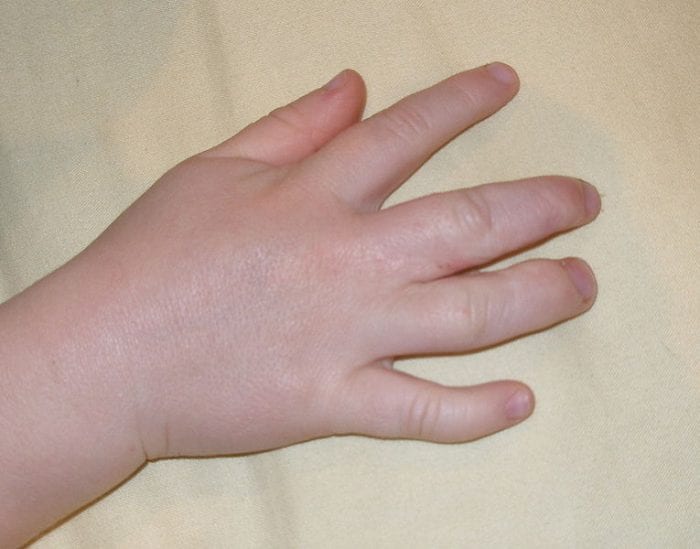
Conclusion
If you do have a good surgery and the trigger finger is gone, you can refer a patient to them. Sometimes when you refer a patient you get credit back, so the idea to refer a patient is a valid form of financial assistance too, since this can be expensive.
If you are worried about trigger thumb in your kid, you can open up the patient portal with your doctor and schedule and appointment. The patient portal can be used for visits, and you can also use the patient portal to pay bills and get help too.
Remember trigger thumb can be temporary, or a long-term problem, but once it’s better your child will feel much happier.
Trigger finger is a bit terrifying. The idea of your toddler not being able to use their fingers properly is a concern. However, with proper treatment, your child should be able to use it quite well. If you suspect your child has it, get a diagnosis, see if they can grow out of it, and if not, it’s time for surgery. Give your toddler lots of love afterward!
FAQs
How do you release a trigger thumb toddler lock?
Trigger thumb may get better on its own, which can take months to years. Another way to treat trigger thumb is through stretching and splinting. You may be taught stretches and massages and be given a splint to hold the thumb straight. The last treatment option to correct trigger thumb is through surgery, and it is performed when your child is between a year or three years old.
What is a pediatric trigger thumb?
Pediatric trigger thumb is when the thumb locks and cannot move freely when your child tries to bend or straighten it. About 3 in 1,000 children can develop this condition, and it typically occurs when the child is between a year and three years old.
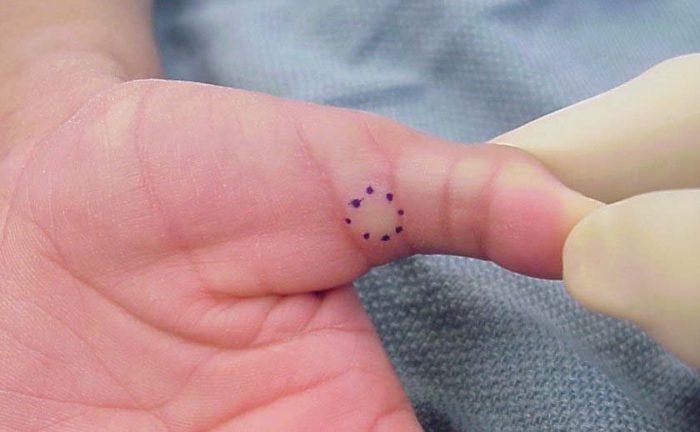
What is the cause of the trigger finger?
Several factors contribute to the development of trigger finger in adults. However, pediatric trigger finger or thumb is not caused by overuse or injury, and neither are they born with it. The ligament or tunnel of tissue where the tendon moves are not wide enough to accommodate the tendon’s movement. This mismatch in size then causes the tendon to swell, which can also cause a bump to form (read further here).
Why is my finger bent after trigger finger surgery?
After the surgery, the patient should be able to move their previously affected finger in smoother motions. The operation works for most cases; however, some studies have shown that the success rate can be lower for those with diabetes. It is best to consult first with your doctor regarding any possible complications.
What is the trigger thumb?
Trigger thumb occurs when you are unable to bend or straighten your thumb correctly. If your toddler has it, they may feel a locking sensation when they move their thumb. It can also cause pain.
Is Trigger Finger genetic?
Trigger finger may develop after birth, and it happens by chance. The condition’s occurrence is not related to genetics or other hereditary diseases.
What is trigger thumb in toddlers?
Just like trigger thumb that occurs in adults, trigger thumb in toddlers is when the tendons used to flex the fingers are unable to glide smoothly within the tunnel. It results in the locking or catching of the thumb. Trigger thumb in toddlers happens to 3 in 1,000 children.
Does trigger thumb require surgery?
Some cases of trigger thumb do not require surgery, and the condition may get better on its own. As mentioned also in nationwidechildrens.org, if this does not happen, and splinting and stretching does not work as well, your doctor may recommend surgery for treatment. Always consult with your doctor before making a decision.
What happens if you don’t treat trigger thumb?
As your child grows, the chances of the trigger thumb healing on its own also decreases. When this happens, the condition may also progress. They may be unable to uncurl their finger without the help of their other hand, or other fingers may also be affected.
Last Updated on June 25, 2022 by Jejomar Contawe
DISCLAIMER (IMPORTANT): This information (including all text, images, audio, or other formats on FamilyHype.com) is not intended to be a substitute for informed professional advice, diagnosis, endorsement or treatment. You should not take any action or avoid taking action without consulting a qualified professional. Always seek the advice of your physician or other qualified health provider with any questions about medical conditions. Do not disregard professional medical advice or delay seeking advice or treatment because of something you have read here a FamilyHype.com.
